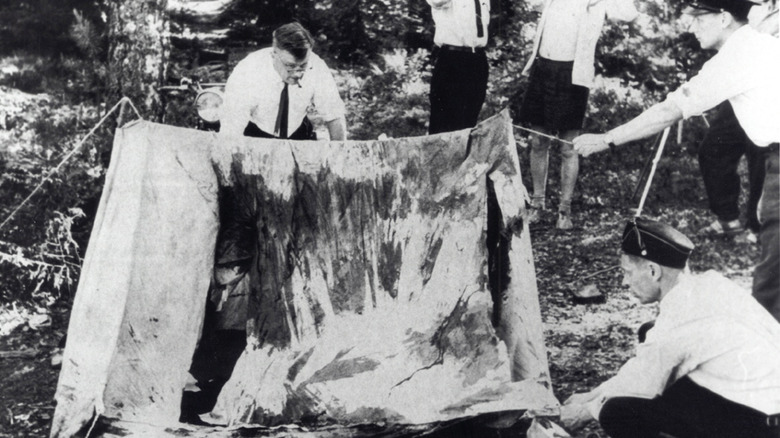The Biggest Lake Bodom Murder Theories: What Really Happened?
In June of 1960, on the shores of a tranquil lake in Finland, three people were murdered by an unknown assailant and the case remains unsolved more than 60 years later. Lake Bodom is a little over 12 miles (20 kilometers) from the Finnish capital of Helsinki, near the town of Espoo. According to Historic Mysteries, on the night of June 5, 1960, it's where two teenage couples — Nils Gustafsson, 18; Irmeli Björklund, 15; Seppo Boisman, 18; and Tuulikki Mäki, 15 — set up tents to camp out and enjoy the pristine wilderness.
The next morning a man who had gone for a swim in Lake Espoo would discover all but one of the teenagers dead, their tent shredded, and their money and clothes stolen. Gustafsson — the sole survivor of the attack — and his girlfriend, Bjorkland were found on top of the tent, while the bodies of their friends Boisman and Mäki remained inside, all with multiple stab wounds.
Police were able to surmise about when the attack took place — thought to be between 4 a.m. and 6 a.m. — and that the attack was likely committed with a knife and blunt object, despite no murder weapon ever being found.
The case has become Finland's most notorious unsolved murder, and even inspired the name of Finnish heavy metal band, Children of Bodom. While the answer to what really happened on the shores of Lake Bodom that night in 1960 may never be known, there is no shortage of theories.
Could the murders have been committed by Nils Gustafsson?
Nils Gustafsson was the only one of the four victims to survive the brutal attack, yet he was unable to give investigators a clear picture of what unfolded. This has led some to question whether he could have been the culprit.
Gustafsson told police that he was attacked first, which led to him becoming disoriented and rendered his recollection of the events faulty. He also claimed that the killer believed him to be dead, and moved on to the others. He did offer up one somewhat helpful piece of information: that the killer was "dressed in black and bright red," per Historic Mysteries.
It's tough to pin the crime on Gustafsson given the extent of his injuries, which according to Mental Floss, also included a broken jaw and a concussion. Additionally, before the actual discovery of the bodies, a group of bird-watchers reported having seen the collapsed tent and a blond-haired man walking away from the scene of the murders (via All That's Interesting). This would cause investigators to look elsewhere for the murderer, but it wouldn't be the last time Gustafsson would come under suspicion.
Violent criminal Pentti Soininen claims responsibility
In the mid-'60s, a criminal with a history of violence by the name of Pentti Soininen bragged to a fellow inmate that he had been the assailant behind the gruesome murders at Lake Bodom, per Historic Mysteries.
Given his violent past, and the fact he lived in the area surrounding the lake at the time of the murders, it seems like Soininen would be a likely suspect. In an eerie coincidence, Soininen would hang himself in prison on June 6, 1969 — the ninth anniversary of the murders.
However, there's a pretty significant argument against Soininen being the culprit: his age. He was only about 14 years old at the time of the attack. Many question if it would even have been possible for him to overpower four older teenagers alone.
While a confession can make a criminal investigation seem like a closed case, given the lack of evidence implicating him — and the arguments against his involvement — it seems unlikely he was the culprit.
Karl Valdemar Gyllström's penchant for violence draws suspicion
If investigators find themselves looking into a case involving the murder of camping children, then it makes sense that they would at some point turn their attention toward the local guy who was known to harbor a hatred of both children and campers. Seeing as he as he was known to throw rocks at campers and cut their tent stakes, Karl Valdemar Gyllström was that guy.
According to Historic Mysteries, Gyllström was known for a history of violent behavior, having previously confessed — before later denying — to drunkenly killed his neighbor.
Neighbors reported seeing him walking home early on the morning of the murders, but knowing his habit of violence and fearing retribution, they did nothing. He was later seen pouring concrete down a well which is obviously an unusual thing to be doing, but investigators ignored this piece of information. Some believe that this may have been a method of hiding murder weapons.
The murders were never officially pinned on Gyllström but there's a bizarre end to his story. While talking with a friend about the murders, Gyllström asked what he should do if he had been involved with the murders, with the friend responding he should go drown himself in the lake, otherwise he'd spend the rest of his life in prison. Not long after, that's exactly what Karl Valdemar Gyllström would do. That's not a confession, but sometimes actions speak louder than words.
Suspected KGB agent Hans Assmann becomes a suspect after a strange hospital visit
Finland borders what is currently Russia, which at the time of the Lake Bodom murders was the Soviet Union. Adding a little 1960s Cold War flavor to this mystery is potential suspect Hans Assmann, a man believed to have been a KGB spy.
According to Historic Mysteries, on the morning of the murders, Assmann appeared at a hospital in Helsinki, with a rather suspicious combination of bloody clothes and dirt under his fingernails. He then would cause a stir in the hospital. He was reportedly speaking incoherently, and when doctors weren't tending to him in as timely a manner as he would've liked, he pretended to be unconscious. It's undoubtedly strange behavior that raises questions, but according to Mental Floss, it's not clear what Assmann was seeking treatment for.
He is said to have had long, blond hair at this time, a fact that would fit with the account made by the birdwatchers who were out at Lake Bodom on the morning after the murders. Police did look into Assmann as a suspect, but apparently, he had an alibi and wasn't pursued any further.
New evidence brings Gustaffson comes under suspicion again 40 years later
By 2004, forensic science had come a long way from where it was at the time of the Lake Bodom murders. It's these scientific advancements that led to Nils Gustafsson — or more accurately, his shoes — going under the microscope once again.
According to Mental Floss, 44 years after the murder, Gustafsson's shoes were tested and were found to have blood from the other three victims on them, but none of his own. The theory was that Gustafsson killed his friends, and then inflicted his injuries — which as previously mentioned, included a broken jaw and concussion — on himself.
Investigators believed that Gustafsson could have been brought to murder by some kind of jealousy, and belief that is actually backed up by a woman who was at a nearby campsite the night of the murders and claimed to have heard an argument between Gustafsson and Boisman. This statement — which was made in court — has led to the theory that Gustafsson's broken jaw may have come courtesy of Boisman in the heat of their argument before Gustafsson lashed out and murdered his friends. It's this theory that could also account for Boisman having been attacked the most viciously, with some of his stab wounds believed to have been inflicted post-mortem (via All Things Interesting).
Charges were brought against Gustafsson in 2005, but it was found that there wasn't enough evidence implicating him in the crimes to warrant a conviction.





